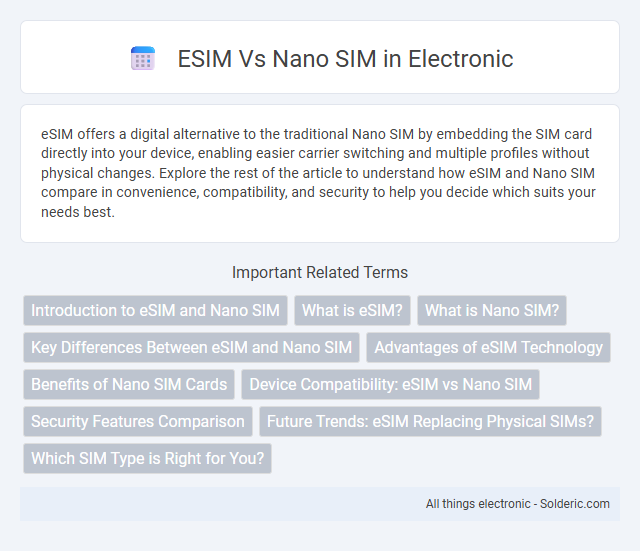eSIM offers a digital alternative to the traditional Nano SIM by embedding the SIM card directly into your device, enabling easier carrier switching and multiple profiles without physical changes. Explore the rest of the article to understand how eSIM and Nano SIM compare in convenience, compatibility, and security to help you decide which suits your needs best.
Comparison Table
| Feature | eSIM | Nano SIM |
|---|---|---|
| Form Factor | Embedded chip inside device | Physical removable card (12.3 x 8.8 mm) |
| Activation | Remote provisioning via QR code or carrier app | Insert physical SIM card |
| Carrier Switching | Instant, multiple profiles supported | Requires physical swapping |
| Device Compatibility | Modern smartphones, tablets, wearables | Most mobile phones, older devices |
| Security | Harder to remove, better anti-theft | Can be removed or swapped easily |
| Durability | Less prone to physical damage | Prone to loss or damage |
| Network Support | Supports LTE, 5G, and future standards | Supports LTE, 5G (depending on device) |
| Cost | No need for physical SIM, may reduce carrier fees | Costs for physical SIM card issuance |
Introduction to eSIM and Nano SIM
eSIM (embedded SIM) is a digital SIM embedded directly into devices, allowing remote activation of mobile plans without needing a physical card. Nano SIM, the smallest physical SIM card size, requires manual insertion and replacement for changing carriers or plans. eSIM technology enhances convenience, space-saving designs, and supports multiple profiles, whereas Nano SIM remains widely used for its simplicity and compatibility.
What is eSIM?
An eSIM, or embedded SIM, is a digital SIM technology that allows you to activate a cellular plan without needing a physical SIM card. Unlike Nano SIMs, which are traditional, removable plastic cards, eSIMs are built directly into your device's hardware, simplifying carrier switching and enabling multiple profiles on a single device. This innovation enhances convenience for travelers and users managing multiple phone numbers or data plans.
What is Nano SIM?
Nano SIM is the smallest physical SIM card available, measuring just 12.3 x 8.8 mm, designed to fit into compact smartphones and offer the same functionality as larger SIM cards. Unlike eSIM, which is embedded directly into the device and can be activated digitally, Nano SIM requires manual insertion and removal for network changes. Your choice between Nano SIM and eSIM depends on device compatibility, convenience, and how you prefer managing your mobile network connections.
Key Differences Between eSIM and Nano SIM
eSIM, or embedded SIM, is a digital SIM integrated into a device, allowing users to activate cellular plans without a physical card, while Nano SIM is a physical SIM card required to be inserted manually. eSIM offers enhanced convenience by supporting multiple profiles and remote provisioning, whereas Nano SIM requires swapping cards to change carriers or plans. Security-wise, eSIMs provide better protection against loss or theft due to their embedded nature, contrasting with the removable Nano SIM.
Advantages of eSIM Technology
eSIM technology offers significant advantages including easier activation and switching between carriers without needing a physical SIM card. It supports multiple profiles on a single device, enhancing flexibility for international travel and business use. Moreover, eSIMs contribute to device design efficiency by saving internal space and improving water resistance.
Benefits of Nano SIM Cards
Nano SIM cards offer widespread compatibility with most smartphones and mobile devices globally, making them a reliable choice for users seeking seamless connectivity. Their compact size allows for efficient use of internal space within devices, enabling slimmer and more lightweight designs. Nano SIM cards also provide easy physical swapping between devices without requiring digital profiles or network reactivation processes.
Device Compatibility: eSIM vs Nano SIM
Device compatibility varies significantly between eSIM and Nano SIM technologies. eSIMs are embedded within newer smartphones, tablets, and smartwatches, supporting multiple carriers without physical card swaps, while Nano SIMs require a physical slot, limiting compatibility to devices designed with this tray. Your choice impacts flexibility and device options, with eSIMs offering broader future-proofing for the latest gadgets.
Security Features Comparison
eSIM offers enhanced security features by embedding the SIM profile within the device, reducing risks of physical theft and SIM swapping attacks common with Nano SIM cards. It supports remote provisioning and encryption protocols that prevent unauthorized access and enable secure over-the-air updates. Nano SIMs rely on physical card security, making them more vulnerable to tampering and cloning compared to the software-based protections of eSIM technology.
Future Trends: eSIM Replacing Physical SIMs?
eSIM technology is rapidly advancing, with major smartphone manufacturers and carriers worldwide adopting this digital SIM format due to its convenience and flexibility. Future trends indicate a significant shift as eSIMs enable remote provisioning and multiple profiles on one device, positioning them to replace traditional Nano SIM cards entirely. Your mobile experience will become more seamless as eSIM adoption grows, eliminating the need for physical SIM swaps and enhancing global connectivity.
Which SIM Type is Right for You?
Choosing between eSIM and Nano SIM depends on device compatibility and convenience preferences. eSIM offers seamless activation and supports multiple mobile profiles without physical swapping, ideal for frequent travelers and tech-savvy users. Nano SIM remains widely compatible with most smartphones and offers straightforward, tactile control, suitable for users who prefer physical cards or switch devices often.
eSIM vs Nano SIM Infographic

 solderic.com
solderic.com